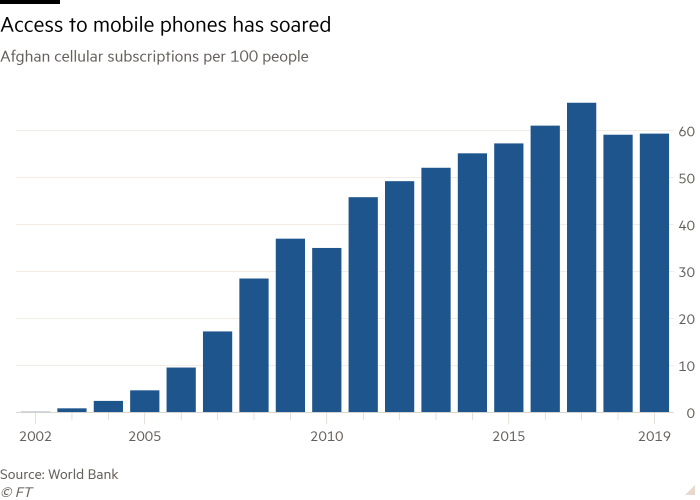In the two decades since the Taliban lost control of Afghanistan living conditions have improved markedly, including huge progress in healthcare, education, life expectancy and child mortality.
But endemic corruption and violence slowed the pace of progress, and the scaling-back of troops and aid in recent years reduced one of its biggest sources of revenue, with economic consequences.
Afghanistan’s former central bank governor Ajmal Ahmady, who fled the country last weekend as the Islamist group returned to power, told the Financial Times that anyone who played down the improvement in the lives of Afghans “belittles the change that has happened”.
But Dr Gareth Price, senior research fellow at think-tank Chatham House, said that while Afghanistan had “changed dramatically” in social terms, “none of the main domestic generators of growth — notably mineral reserves — have been significantly tapped, aside from illegal mining”.
The economy grew — but is now stagnating
Living standards benefited from a double-digit economic expansion up to the mid-2010s. But output has stagnated over the past decade as international financial support declined.
Aid flows fell from about 100 per cent of GDP in 2009 to 42.9 per cent in 2020 according to the World Bank, constraining services sector activity and employment.
International money is expected to dry up completely under the Taliban, threatening the survival of Afghanistan’s legal economy.
“With much of the economic progress of the last 20 years being built on external support, the return of Afghanistan to global pariah status is likely to see the rug pulled from under the economy,” warned Gareth Leather, Asian economist at Capital Economics. “A large contraction in GDP and backsliding in socio-economic development appears all but certain.”

Cutting off aid “will potentially cripple a large part of the modern economy and services jobs”, said Anthony H. Cordesman of the Center for Strategic and International Studies, a think-tank. He questioned how Afghanistan could create a “licit” economy if aid was cut off.
Afghanistan legally exported only about $1bn of goods in 2020, according to the International Trade Centre, a multilateral agency — less than neighbouring Tajikistan, despite its population being four times larger.
Half of its official exports are composed of grapes and other fresh fruit, although the importance of agriculture has declined as the service sector expanded.

But Leather warned that official data should be taken with a pinch of salt as “one of Afghanistan’s biggest products is illegal opium, which of course does not show up in national accounts”.
Experts have concluded that the informal economy comprises as much as 80 per cent of overall Afghan economic activity, meaning that official growth estimates are of only limited utility.
Living standards improved
Despite the patchy overall economic performance, many Afghans’ day-to-day lives notably improved. Healthcare and education became more widespread, mortality rates declined and technology use became common.
About 60 children aged under 5 died in 2019 per 1,000 born, according to the World Bank — that figure has halved since the turn of the century, the fastest reduction in child mortality across all low-income countries.

The proportion of children underweight more than halved in the same period, and Afghanistan logged a similar reduction in the risk of maternal death.
Healthcare also improved across a range of measures, and nearly half the population have access to sanitation, up from a quarter in the early 2000s.

As a result, Afghan people now live nearly 10 years longer than they did two decades ago.
Educational performance also improved significantly. There are about 8.2m more children in school than in 2001, and the proportion of children enrolled in secondary education jumped from 12 per cent in 2001 to 55 per cent in 2018.

“A vastly greater number of young Afghans have had real education,” said Cordesman.
However he stressed that limited information meant the available data was sometimes “guesstimates”.

Women in particular have benefited
Women’s lives improved across a swath of indicators. Girls’ enrolment in education has jumped, adolescent fertility rates plummeted and many more women are in work.

“Huge gains were made over the last two decades on girls’ education,” said Susannah Hares, co-director of education policy at the Centre for Global Development, a think-tank. But she warned that “these are now at great risk of being rapidly rolled back . . . we’re likely to see many, many Afghan girls forced to leave school”.

Women also entered the workforce in much larger numbers than previously. Last year, about one-fifth of Afghan civil servants were women and one in four parliamentary seats were held by women — up from zero in 2001.
But violence and poverty still prevalent
Despite the progress, the Taliban has taken charge of one of the most fragile economies in the world. Hardly any country is less hospitable to business, or more corrupt.
Afghanistan was 165 of 180 countries in Transparency International’s corruption index in 2020 — though it has risen 11 places since 2012.
“Private sector development and diversification is constrained by insecurity, political instability, weak institutions, inadequate infrastructure, widespread corruption, and a difficult business environment,” according to the World Bank, which rated Afghanistan 173 of 190 countries in its 2020 doing business survey.

Life expectancy is still eight years lower than the world average, and five years below the South Asian average.
Living standards are the lowest in the region, and more than half of the population lives below the poverty line. On measures of health, personal freedom, living conditions, trust in institutions, safety and security, Afghanistan is still among the worst in the world.
Despite this, the former central bank governor Ahmady warned that the reversal of the past two decades of progress would have a substantial impact on ordinary Afghans’ lives.
“You have a situation in Afghanistan where every single person has a cell phone and that’s a lifeline for many people,” he said. “There’s been significant economic advances and [the coming deterioration] is going to be, I think, a shock for most of them.”

